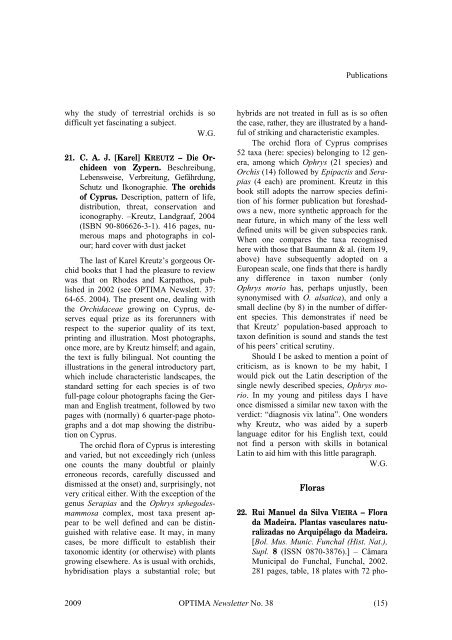OPTIMA Newsletter 38
OPTIMA Newsletter 38
OPTIMA Newsletter 38
You also want an ePaper? Increase the reach of your titles
YUMPU automatically turns print PDFs into web optimized ePapers that Google loves.
why the study of terrestrial orchids is so<br />
difficult yet fascinating a subject.<br />
W.G.<br />
21. 20BC.<br />
A. J. [Karel] KREUTZ – Die Orchideen<br />
von Zypern. Beschreibung,<br />
Lebensweise, Verbreitung, Gefährdung,<br />
Schutz und Ikonographie. The orchids<br />
of Cyprus. Description, pattern of life,<br />
distribution, threat, conservation and<br />
iconography. –Kreutz, Landgraaf, 2004<br />
(ISBN 90-806626-3-1). 416 pages, numerous<br />
maps and photographs in colour;<br />
hard cover with dust jacket<br />
The last of Karel Kreutz’s gorgeous Orchid<br />
books that I had the pleasure to review<br />
was that on Rhodes and Karpathos, published<br />
in 2002 (see <strong>OPTIMA</strong> Newslett. 37:<br />
64-65. 2004). The present one, dealing with<br />
the Orchidaceae growing on Cyprus, deserves<br />
equal prize as its forerunners with<br />
respect to the superior quality of its text,<br />
printing and illustration. Most photographs,<br />
once more, are by Kreutz himself; and again,<br />
the text is fully bilingual. Not counting the<br />
illustrations in the general introductory part,<br />
which include characteristic landscapes, the<br />
standard setting for each species is of two<br />
full-page colour photographs facing the German<br />
and English treatment, followed by two<br />
pages with (normally) 6 quarter-page photographs<br />
and a dot map showing the distribution<br />
on Cyprus.<br />
The orchid flora of Cyprus is interesting<br />
and varied, but not exceedingly rich (unless<br />
one counts the many doubtful or plainly<br />
erroneous records, carefully discussed and<br />
dismissed at the onset) and, surprisingly, not<br />
very critical either. With the exception of the<br />
genus Serapias and the Ophrys sphegodesmammosa<br />
complex, most taxa present appear<br />
to be well defined and can be distinguished<br />
with relative ease. It may, in many<br />
cases, be more difficult to establish their<br />
taxonomic identity (or otherwise) with plants<br />
growing elsewhere. As is usual with orchids,<br />
hybridisation plays a substantial role; but<br />
Publications<br />
hybrids are not treated in full as is so often<br />
the case, rather, they are illustrated by a handful<br />
of striking and characteristic examples.<br />
The orchid flora of Cyprus comprises<br />
52 taxa (here: species) belonging to 12 genera,<br />
among which Ophrys (21 species) and<br />
Orchis (14) followed by Epipactis and Serapias<br />
(4 each) are prominent. Kreutz in this<br />
book still adopts the narrow species definition<br />
of his former publication but foreshadows<br />
a new, more synthetic approach for the<br />
near future, in which many of the less well<br />
defined units will be given subspecies rank.<br />
When one compares the taxa recognised<br />
here with those that Baumann & al. (item 19,<br />
above) have subsequently adopted on a<br />
European scale, one finds that there is hardly<br />
any difference in taxon number (only<br />
Ophrys morio has, perhaps unjustly, been<br />
synonymised with O. alsatica), and only a<br />
small decline (by 8) in the number of different<br />
species. This demonstrates if need be<br />
that Kreutz’ population-based approach to<br />
taxon definition is sound and stands the test<br />
of his peers’ critical scrutiny.<br />
Should I be asked to mention a point of<br />
criticism, as is known to be my habit, I<br />
would pick out the Latin description of the<br />
single newly described species, Ophrys morio.<br />
In my young and pitiless days I have<br />
once dismissed a similar new taxon with the<br />
verdict: “diagnosis vix latina”. One wonders<br />
why Kreutz, who was aided by a superb<br />
language editor for his English text, could<br />
not find a person with skills in botanical<br />
Latin to aid him with this little paragraph.<br />
W.G.<br />
Floras<br />
22. 21BRui Manuel da Silva VIEIRA – Flora<br />
da Madeira. Plantas vasculares naturalizadas<br />
no Arquipélago da Madeira.<br />
[Bol. Mus. Munic. Funchal (Hist. Nat.),<br />
Supl. 8 (ISSN 0870-<strong>38</strong>76).] – Câmara<br />
Municipal do Funchal, Funchal, 2002.<br />
281 pages, table, 18 plates with 72 pho-<br />
2009 <strong>OPTIMA</strong> <strong>Newsletter</strong> No. <strong>38</strong> (15)






